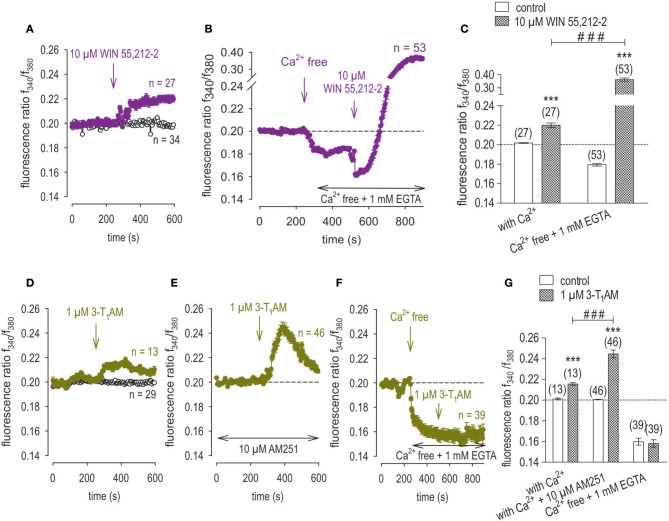Figure 11.
3-T1AM modulation of TRPV1 is associated with cannabinoid receptor type 1 activity. Drugs were added at the indicated time points (arrows). Data are mean ± SEM of 13–53 Ca2+ traces in each set of experiments. (A) WIN 55,212-2 (10 μM) induced a Ca2+ increase, (n = 27). Non-treated control cells showed a constant Ca2+ baseline (n = 34). (B) Ca2+ free condition reduced the intracellular Ca2+ level (baseline) and extracellular application of WIN 55,212-2 (10 μM) strongly increased the intracellular Ca2+ level (n = 53). (C) Summary of the experiments with WIN 55,212-2 with and without external Ca2+. The asterisks (***) show significant Ca2+ increases with WIN 55,212-2 (n = 27 - 53; ***p < 0.005; paired tested). The hashtags (###) show significant stronger Ca2+ increase under external Ca2+ free conditions (n = 53; ###p < 0.005; unpaired tested). (D) Mean trace showing 3-T1AM-induced Ca2+ increase (n = 13) whereas non-treated control cells showed a constant Ca2+ baseline (n = 29). (E) Same experiment as shown in (D), but in the presence of AM251 (10 μM) (n = 46). The 3-T1AM-induced Ca2+ increase is at higher levels compared to the effect without the CB1 blocker. (F) Same experiment as shown in (B), but with 1 μM 3-T1AM instead of WIN 55,212-2. 3-T1AM did not change the intracellular Ca2+ concentration. (G) Summary of the experiments with 3-T1AM with and without AM251 or external Ca2+. The asterisks (***) show significant Ca2+ increases with 3-T1AM (n = 13–46; ***p < 0.005; paired tested). The hashtags (###) show significant difference of the 3-T1AM-induced Ca2+increase with and without AM251 (n = 13–46; ###p < 0.005; unpaired tested).

